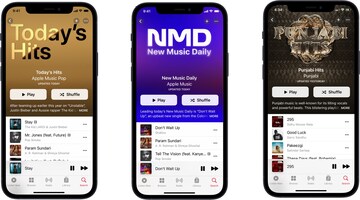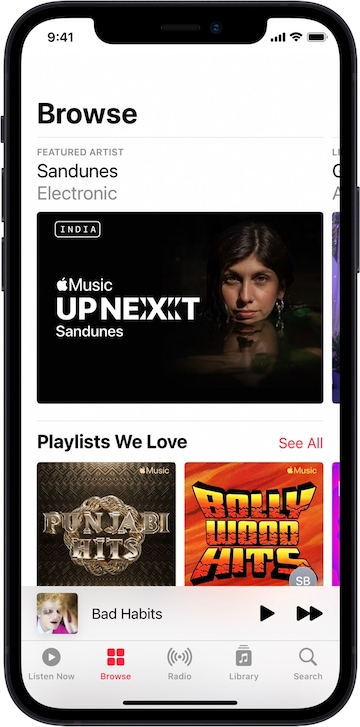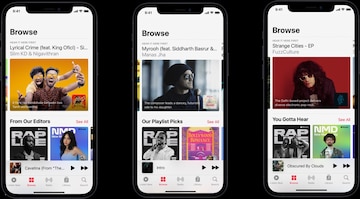
Spotify may be the undisputed king of music streaming globally but since launching in 2015, Apple Music has been chipping away at it and gaining ground. And earlier this year, just a couple of months ago in June, it dropped arguably its most dramatic update, which could reinvent the way it streams music. Over the course of the past couple of years, working in tandem with its own galaxy of gadgets, Apple Music has been building a catalogue of the spatial audio, which could be the biggest innovation to audio since stereo. At the same time, it has added lossless and high-resolution audio at no additional cost, making it an instant hit for snooty audiophiles. While doing so its team of Apple Music editors have also been hard at work surfacing local talent with a combination of playlists and initiatives, which have even touched upon the local independent music community in India. From legends like AR Rahman to upstarts like Prabh Deep all have been touched by the towering influence of the de facto number 2 in the streaming business. But as Apple chases Spotify, its updates to the core service this year have been so dramatic that it begs a review.
Of all the things that Apple has added to Apple Music, high resolution and lossless audio were the lowest hanging fruit. High-resolution audio has been a thing for a while with Tidal leading the charge followed by Amazon Music, so it was kind of obvious that the inventor of the iPod had to get in on the gravy train at some point. It also was important for Apple as it is the world’s biggest seller of earphones thanks to the titanic success of AirPods, its ownership of Beats and the fact for years Apple’s white earphones have been the "daal chawal" of personal audio.
Withstanding a bewildering beta testing period for the launch of the high-resolution audio avatar of Apple Music in India, its implementation is just short of being peerless. If I heard through a compatible audio system, something which Apple strangely doesn’t provide, tracks either in the lossless (slightly compressed) or high-resolution format sound rich, detailed and pleasing to the ear. It also sounds better than Tidal at least to my own ears which pioneered the idea of beaming high-resolution audio on the internet. As is always the case, it sounds best when heard from either traditional PC or Apple’s own gadgets provided that they have been supplemented with a Digital To Analogue (DAC) with compatible earphones or headphones or speakers. Apple’s own wireless earphones or headphones don’t support the uncompressed high-resolution format as Bluetooth isn’t a powerful enough medium to beam it but the fact that AirPods Max which cost upwards of Rs 50,000 doesn’t have a 3.5mm capable hardware is infuriating further exaggerated by the fact Apple’s own iPads and iPhones helped make the antiquated yet stunningly effective headphone jack extinct. If you have an Apple gadget you need a dongle which ideally should also redouble as a DAC with compatible earphones or headphones to make it work. But high-resolution audio has always been a hard-working man’s job. Apple makes you work even harder as you can’t get the best experience even on Android because the app doesn’t bypass some limitations of the operating system, something which Tidal does very expertly.

The slightly compressed lossless format is easier to access as it works well with the AirPods Max as well via Apple’s own 3.5mm lightning adaptor which is shockingly expensive. Apple’s smart speakers, the HomePod and HomePod Mini also play high-resolution audio when the signal is pipped via the latest generation Apple TV 4K. I tested this in great detail with 4 HomePods and 2 HomePod Minis running in sync. Aside from the inconvenient way you need to get this to work, it works really well and elevates the quality of audio you can experience over a home Wi-Fi network. All these hoops don’t matter much considering this update is "Free” while the same is offered at a premium price by Tidal in the US and even Spotify which hasn’t launched this feature yet in India. Free means, Apple is democratising a better standard of sound for everyone and the consumer is the winner. Imagine all of this can be had for just Rs 149 per month for the entire family that too giving you 75 million songs in the format which is more than Tidal.
While high-resolution audio is strangely haphazard in implementation there are no such hoops to be had with Spatial Audio which Apple has been building towards for a couple of years and has also worked with Dolby for its implementation called Atmos, the object-oriented spatial audio technology it is known to deliver in cinemas. Apple has been working on this technology from the ground up and has integrated it across all its devices. From the software to the accelerometer to the gyroscope to the headphones/ speakers Apple has in one swoop deployed it across its entire product portfolio. Then on the content side, Apple went about working with all kinds of artists to adapt their music in the technology.
Even stalwarts like AR Rahman say it could be a game-changer for the way people consume audio. "The ability to experience music in its purest form is magical, and since live concerts have taken a back seat in recent times, Dolby Atmos is an excellent way for my listeners to feel as if they're listening to me live. Music creation is a very personal process, and you always hope the listener is able to feel and receive all that the music is designed to deliver. From the maker to the audience, you hope for minimum intervention in the transit process, and now with the advent of technology, we are able to transcend our creations to millions across the globe. With Apple Music and Spatial Audio, we've recreated the songs of "99 Songs", "Meri Pukar Suno" and "Dil Bechara" in a newer, richer way; and I hope the audiences are able to experience the music in a manner it should be,” said the Oscar winner when asked about the technology which brings another dimension of realism to the audio.

If high-resolution audio is about recreating the studio recording of the music as intended by the musician — spatial audio is all about recreating how one experiences audio in the live context, mirroring the experience of a live performance. And Apple has nailed the implementation which potentially makes it the next best thing since stereo. With Apple and Dolby working together for its furtherment, it has been developed in such a way that when musicians create music purposefully designed for the format, it will delight the listener. It is a jump akin to going from SD video to HD video something which even high-resolution audio is also not able to recreate. Expectedly, Apple is doing everything in its power to propel it, so much so that it has been made available to even Android users.
The genius of spatial audio is that the audio sounds livelier, it also balances the loudness levels as all instruments aren’t firing from all speakers but are coming in directionally. But it works best with music that’s been recorded keeping spatial audio in mind which leverages Apple’s entire hardware stack and software stack that has been co implemented with Dolby’s Atmos software layering. Remastered tracks also have these traits but the effect is not as dramatic.
But Apple is pushing hard as it makes some of the most important tools for the creation of music and it is using that equity to push spatial audio. GarageBand on the Mac has been a staple for years for amateurs and hobbyists which then went on to the iPhone and iPad. Then Apple is building more authoring tools within Logic Pro - the digital audio workstation it has sold for over two decades, enabling compositions to be produced in spatial audio. It has also worked with Dolby and many studios across the world and enabled sound engineers to use the format. All of this is hard work as from the outside it seems like Apple just flipped a switch but it did way more than that.
For example, if you look at an upcoming local act like Delhi-based rapper Prabh Deep is part of the Apple Music “The Up Next Local Artist Program” in India. Apple uses a combination of AI and human curation to deliver you the best music in accordance with your tastes. This has always been a key differentiating point of the service as opposed to Spotify but in recent times it has amped up both the AI and the human aspect to another level. Prabh Deep who is part of “The Up Next Local Artist Program” has been provided support to put him on the same playing field as someone like AR Rahman. It even helps him to compile his music in spatial audio.
"Being a part of campaigns like 'Up Next Local' puts us on the same footing as some of the biggest artists in the world. It has allowed me to expand my creative network as well as my audience and has helped me evolve as an artist. When you're an artist that's going against the grain - it's important for platforms such as Apple Music to provide avenues of support so that we keep pushing boundaries. And now as well, being able to listen to my music in Dolby Atmos has opened up a whole new frontier for my creativity. The ability to visualise my sonic experience - having in-depth control over how it's experienced by the listener - is something that I've always yearned for as a creator. Once you've experienced music in Atmos, you'll never go back to just listening in stereo,” he says.

Indian rap sensation Divine also echoes Prabh Deep’s sentiments. "I’m honored to be amongst the first few artists who get to share their music in Spatial Audio with fans on the platform. To be able to present my music in outstanding sound and clarity and with an immersive experience to my fans is an important milestone for me,” he said.
All of this is handled by an army of Apple Music editors, who are even stationed in India. India’s editorial team is headed by ex Rolling Stone India Editor Bobin James. Globally, there are more than 30,000 playlists and even in India, there are playlists in 8 different languages. Now there are playlists for spatial audio as well including one dedicated to Bollywood music. Apple’s editorial team has even worked with AR Rahman, Prabh Deep, Divine, and Amit Trivedi to create dedicated playlists for their music so that people can understand the difference.
In India, some artists also get exclusive releases where the Editorial team works with artists to launch the track on only Apple Music giving it a content differentiation to something like Gaana.com or Spotify. Since 2017, over 85 such releases have happened in India only with acts like FuzzCulture and SunDogProject being featured.
Its City Charts are also currently restricted to the big cities of Mumbai, New Delhi, and Bengaluru which helps it rank the top 25 songs gaining momentum in a hyper-local area. But Apple has also amped up its AI on the service. Its “listen now” feature works in tandem with the human curation and it is starting to approach levels that can start to stand in the same league as Spotify’s stellar recommendations engine.
Apple Music is trying to achieve something audacious with the recent slew of updates which according to me can perhaps only be matched by an Amazon or Google, but not Spotify. But these tech giants aren’t anywhere close to where Apple is with audio and nor do they have the legacy in audio that it has. It needs a blend of things that makes Apple Music special. It is the coming together of Apple’s industry-leading nous in chip making, its on-device artificial intelligence, its ecosystem of gadgets - that incorporate spatial audio from a conceptual level, its understanding of music and its standing in the music industry as the pioneering digital platform and toolmaker and a human touch with its masterful editorial teams, which now are tailoring just not the tastes of the listeners but nudging the creators towards using its game-changing new technologies. It's a vertically integrated stack that’s delivered at a global hyper-scale while going hyper-local from tech to content at an immensely affordable price. If this is not the reinvention of the way we listen to music then I don’t know what is.
Check out our in-depth Market Coverage, Business News & get real-time Stock Market Updates on CNBC-TV18. Also, Watch our channels CNBC-TV18, CNBC Awaaz and CNBC Bajar Live on-the-go!


Supreme Court says it may consider interim bail for Arvind Kejriwal due to ongoing Lok Sabha polls
May 3, 2024 4:57 PM
10% discount on fare on Mumbai Metro lines 2 and 7A on May 20
May 3, 2024 2:40 PM

